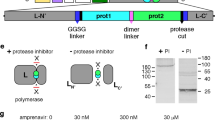Abstract
Expression of viral genes in tumour cells of the virus-associated cancers could provide highly selective ways of targeting expression of therapeutic vectors to the tumour cells. The ubiquitous presence of EBNA-1 in Epstein–Barr virus-associated cancers could be used to activate expression constructs containing oriP in the tumour cells. This is demonstrated for a variety of model systems including epithelial cells, which would be the target cell type for the treatment of undifferentiated nasopharyngeal carcinoma, a cancer that always contains Epstein–Barr virus in the tumour cells. Combining an oriP/EBNA-1-dependent Epstein–Barr virus Cp promoter with delayed assay of reporter gene, a 108-fold differential was obtained between the activity of a transfected plasmid in cells containing or lacking EBNA-1 expression. This might provide sufficient specificity for a successful in vivo therapeutic strategy.
This is a preview of subscription content, access via your institution
Access options
Subscribe to this journal
Receive 12 print issues and online access
$259.00 per year
only $21.58 per issue
Buy this article
- Purchase on Springer Link
- Instant access to full article PDF
Prices may be subject to local taxes which are calculated during checkout
Similar content being viewed by others
Author information
Authors and Affiliations
Rights and permissions
About this article
Cite this article
Evans, T., Brooks, L. & Farrell, P. A strategy for specific targeting of therapeutic agents to tumour cells of virus-associated cancers. Gene Ther 4, 264–267 (1997). https://doi.org/10.1038/sj.gt.3300392
Received:
Accepted:
Issue Date:
DOI: https://doi.org/10.1038/sj.gt.3300392



